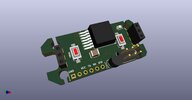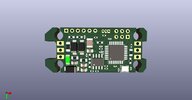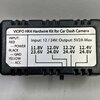HK3-H - the new hardware kit for Viofo dashcams (and most other), where "H" stands for "Homebrew"!
Well, after 3 failed HK3 kits, a year of frustration with random power issues on existing hardware kit leading to missed records, few cases of beers and a free weekend - I have finally designed my own hardware kit that is about to go into assembly and testing! Rest easy Viofo, I am not planning on commercial manufacturing of these and created one purely for my own personal use. After-all this would probably cost at least twice as much if not more as the original kit.
The design relies on quality components where the power circuit is based on military grade integrated converter from TI (why military grade? - because it is the only one I could source that fit my criteria and industrial application rated converters with the same footprint are still in shortage). The logical side is handled by Atmega328P - Yes, I know, a major overkill, but it will allow me to do some other experiments and transmit valuable data for testing.
So, what does it do? Pretty much the same thing as the original kit, but with a lot more finetuning and some expansion capabilities. Below are few stats and ideas:
- fits into existing HK3 casing, but needs manual soldering in place
- supports parking mode
- high efficiency 5V 3A rated Integrated DC-DC converter from TI (can be replaced with up to 10A module in case if I decide to have 20 cameras running at once lol)
- a button for programming low voltage cut-off and other parameters (the integrated DC power module actually supports this by default, but I want to add a delay for cut-off for those moments when battery can dip briefly, such as while starting a car)
- high precision voltage sensor from TI
- led indicator which can be turned on/off
- temperature sensor (mainly for testing)
- data logging stored in long term memory: peak temperature, highest and lowest voltage points, number of car start-ups... whatever else I can come up with
- addition of solder-in module adds ability to transmit data wirelessly to my smart-home ecosystem with remote controls of the HK kit
Wanted to share this with you guys and hoping to hear some feedback and maybe other stupid or crazy ideas for added functionality!
Below are 3D renders of the board. I am planning to order it next week (want to give some time for feedback in case if anyone is interested).


Well, after 3 failed HK3 kits, a year of frustration with random power issues on existing hardware kit leading to missed records, few cases of beers and a free weekend - I have finally designed my own hardware kit that is about to go into assembly and testing! Rest easy Viofo, I am not planning on commercial manufacturing of these and created one purely for my own personal use. After-all this would probably cost at least twice as much if not more as the original kit.
The design relies on quality components where the power circuit is based on military grade integrated converter from TI (why military grade? - because it is the only one I could source that fit my criteria and industrial application rated converters with the same footprint are still in shortage). The logical side is handled by Atmega328P - Yes, I know, a major overkill, but it will allow me to do some other experiments and transmit valuable data for testing.
So, what does it do? Pretty much the same thing as the original kit, but with a lot more finetuning and some expansion capabilities. Below are few stats and ideas:
- fits into existing HK3 casing, but needs manual soldering in place
- supports parking mode
- high efficiency 5V 3A rated Integrated DC-DC converter from TI (can be replaced with up to 10A module in case if I decide to have 20 cameras running at once lol)
- a button for programming low voltage cut-off and other parameters (the integrated DC power module actually supports this by default, but I want to add a delay for cut-off for those moments when battery can dip briefly, such as while starting a car)
- high precision voltage sensor from TI
- led indicator which can be turned on/off
- temperature sensor (mainly for testing)
- data logging stored in long term memory: peak temperature, highest and lowest voltage points, number of car start-ups... whatever else I can come up with
- addition of solder-in module adds ability to transmit data wirelessly to my smart-home ecosystem with remote controls of the HK kit
Wanted to share this with you guys and hoping to hear some feedback and maybe other stupid or crazy ideas for added functionality!
Below are 3D renders of the board. I am planning to order it next week (want to give some time for feedback in case if anyone is interested).



